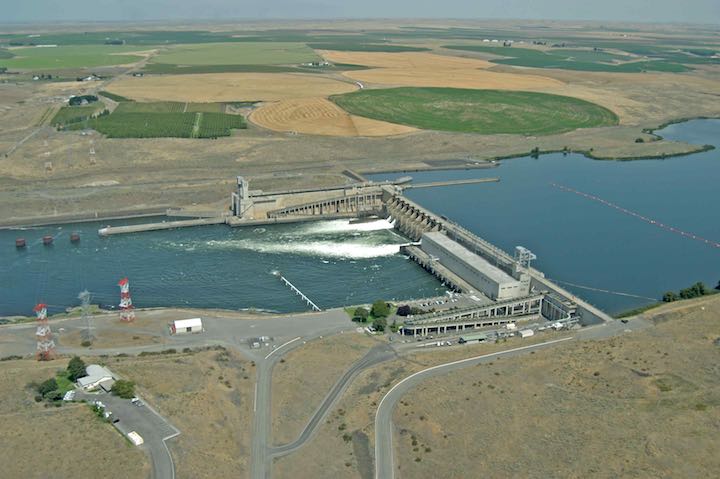forum
library
tutorial
contact

Feds Balk at Breaching Dams
by Don JenkinsCapital Press, March 2, 2020
|
the film forum library tutorial contact |

|
Feds Balk at Breaching Damsby Don JenkinsCapital Press, March 2, 2020 |
 The Draft Environmental Impact Statement (DEIS) for Columbia River System Operations released on Feb. 28 rejects breaching four Lower Snake River dams in southeast Washington, finding it would raise transportation and production costs for farmers, while also increasing greenhouse gases, raising electric rates and making the Northwest more vulnerable to power blackouts.
The Draft Environmental Impact Statement (DEIS) for Columbia River System Operations released on Feb. 28 rejects breaching four Lower Snake River dams in southeast Washington, finding it would raise transportation and production costs for farmers, while also increasing greenhouse gases, raising electric rates and making the Northwest more vulnerable to power blackouts.
This "preferred alternative" is one of six alternatives provided in the DEIS.
Public comment on the DEIS is open until April 13.
The draft environmental impact statement, produced jointly by the U.S. Army Corps of Engineers, Bonneville Power Administration and Bureau of Reclamation, drew immediate criticism from environmental groups that advocate breaching the dams to increase fish runs.
The DEIS considered removing earth on the sides of Ice Harbor, Lower Monumental, Little Goose and Lower Granite dams. It concluded that breaching the dams would have the most benefits for endangered salmon. Several Indian tribes said it was the best option for offsetting the river system's harm to treaty rights.
But breaching would not allow federal operators to meet the congressional mandate to maintain the dams for navigation, hydropower and irrigation, according to the report. "It also has the highest adverse impacts to other resources, especially social and economic effects," the report states.
New congressional authority and funding would be needed to breach the dams, according to the DEIS.
The study looked at the entire Columbia River hydropower system, made up of 14 federally controlled dams and reservoirs in Washington, Oregon, Idaho and Montana.
The report's "preferred alternative" on operating the system includes modifying some fish-passage structures. Also, spilling more water over dams would benefit endangered runs of salmon and steelhead in the Lower Columbia and Snake rivers, according to the report.
Today's release opens another round of public comments on the dams' future. The comment period will close April 13.
The Center for Biological Diversity issued a statement accusing the report of giving "short shrift to the only viable alternative for saving salmon and ultimately orcas — removing the four lower Snake River dams."
The organization said it will seek one million signatures from supporters of breaching the four dams.
The report itself acknowledged the matter wasn't settled. "This EIS is not expected to end the regional debate on the future of the four lower Snake River dams. On the contrary, this EIS provides information and analysis to inform that future dialogue," the report states.
Breaching the dams would have major long-term benefits to fish in the Snake River because of improved rearing and migration conditions, according to the draft EIS. Estimating the number of fish that would survive and return to spawn is difficult because of the uncertainty of ocean survival, the draft states.
Drawing down the water behind the dams could expose 14,000 acres that are currently underwater. The long-term goal would be to return the river to its natural state, benefiting tribal fishing, gathering and occupation, as well as rafting and other recreation, according to the report.
The report warned of high economic costs that would be felt throughout the Northwest.
Breaching the dams would approximately double the region's chances of a power blackout — to nearly once every seven years, the report estimates.
The power could be replaced by more natural gas-generated electricity, but that would increase the emissions of power-related greenhouse gases by 10% in the Northwest and would cost about $1 billion a year, or one-third of BPA's revenues, the report states
"If Bonneville had to replace the lower Snake River projects' full capability with zero-carbon resources, the rate pressure could be up to 50 percent on wholesale power rates," the report states.
Breaching the dams also would increase transportation-related greenhouse gases, as trucks and trains replace barges, according to the report. Greenhouse gases from transporting wheat would increase by 53%, according to the report.
Wheat accounted for 87% of the downriver tonnage on the Lower Snake River in 2018. The report estimated transportation costs would increase by 7 cents to 24 cents a bushel, or a 10% to 33% increase.
Farmers also could pay more for the upriver delivery of products such as fertilizer, according to the report.
The increased truck and train traffic would increase air pollution and likely require public and private spending to expand highways and rail lines. Railroad company may raise rates with less competition from barges, the report states.
Commercial cruise lines that operate on the Columbia and Snake rivers also would be hurt by the loss of the dams as navigation to the ports of Lewiston, Clarkston, Whitman County and Garfield would be curtailed, according to the report. Jobs would be lost and communities such as Clarkston, Lewiston and Asotin "would lose their 'river port' community identity."
The preferred alternative seeks to balance the river system's goals and would test whether increased spills would improve fish runs, according to the report. The approach is expected to have minor benefits for wild fish outside the Snake River.
Increasing spring spills for fish would raise BPA rates by an estimated 2.7%, but not make the power system less reliable. The reduction in hydropower would only marginally increase greenhouse gas emissions, the report states.
learn more on topics covered in the film
see the video
read the script
learn the songs
discussion forum
